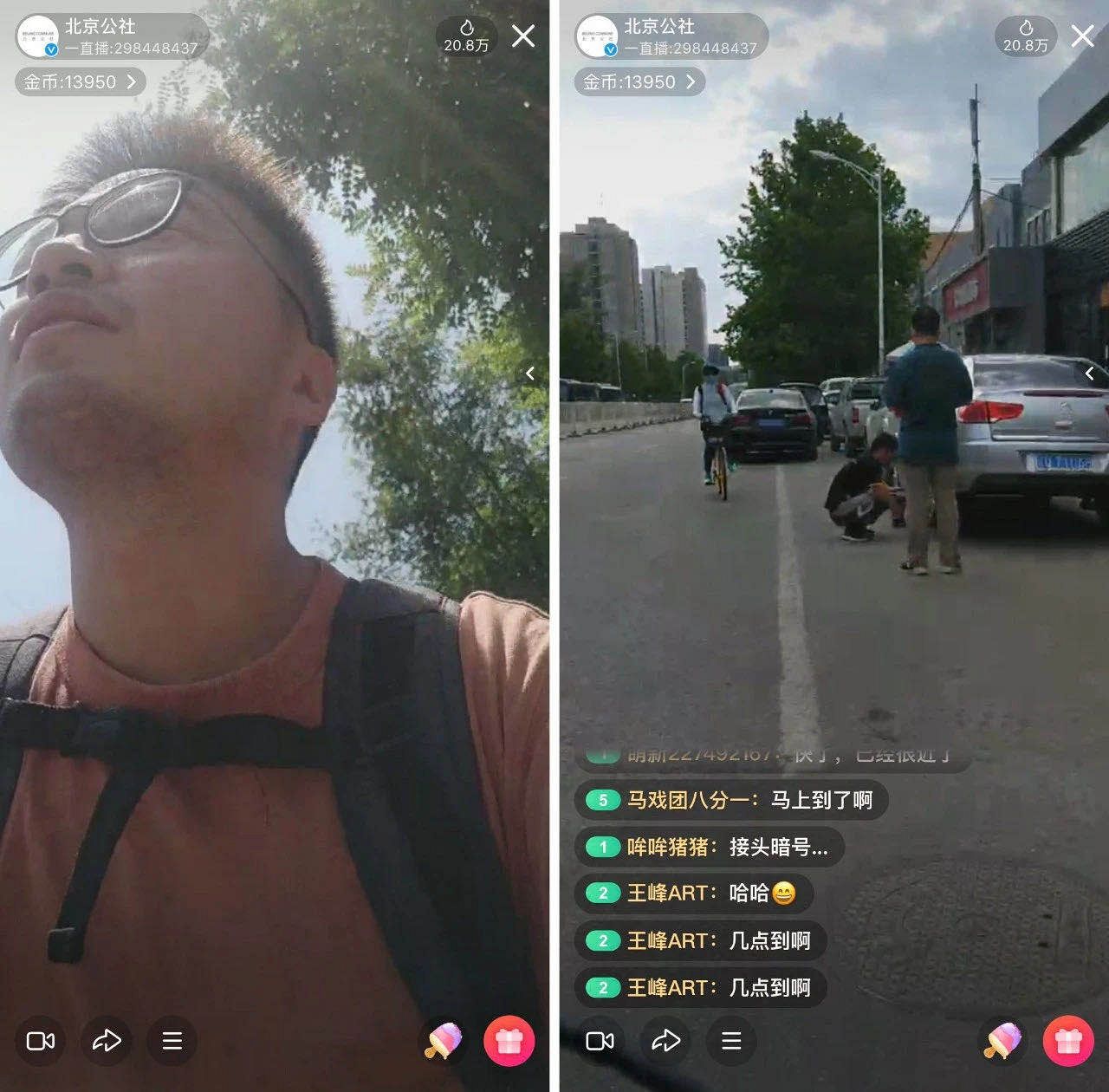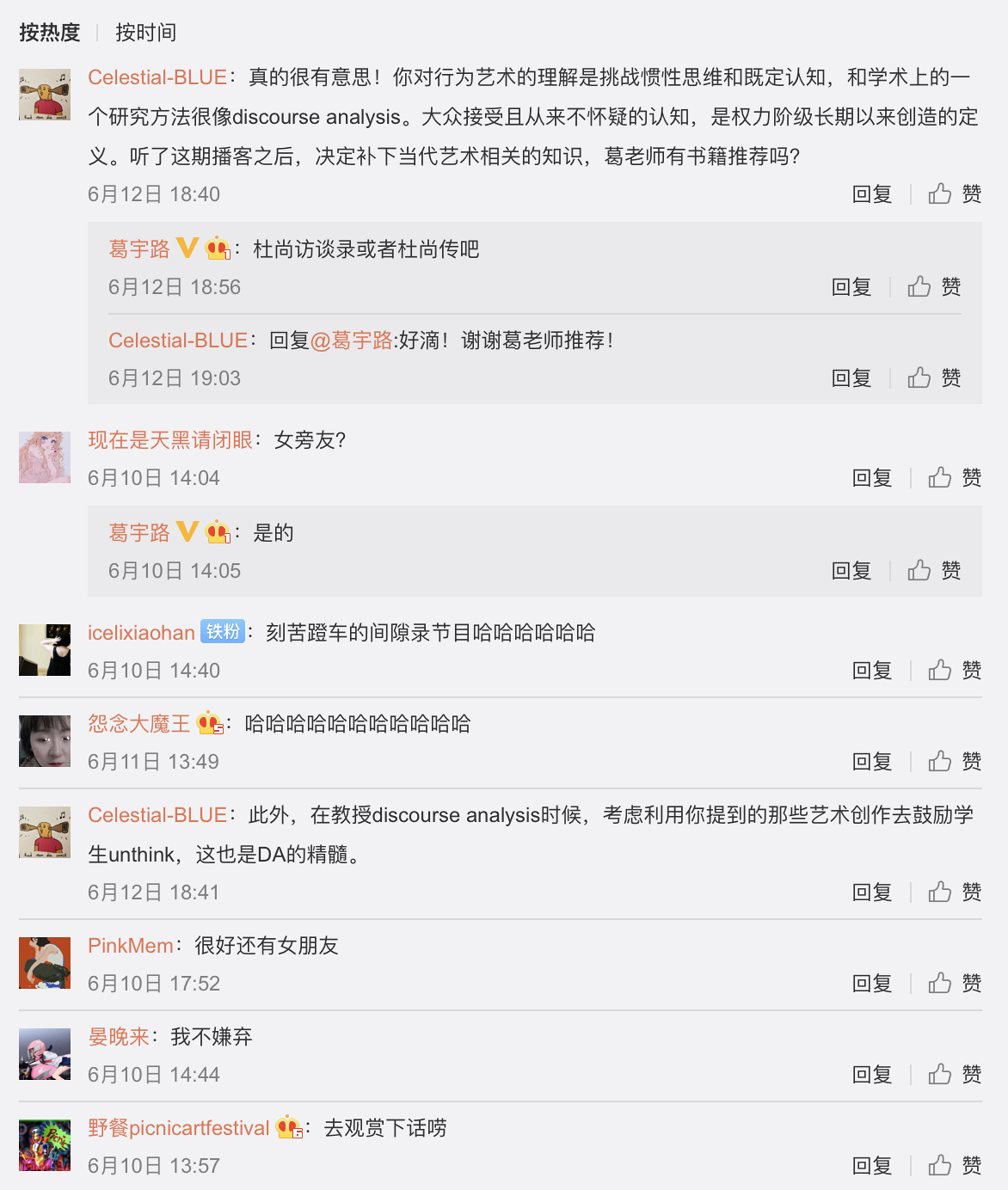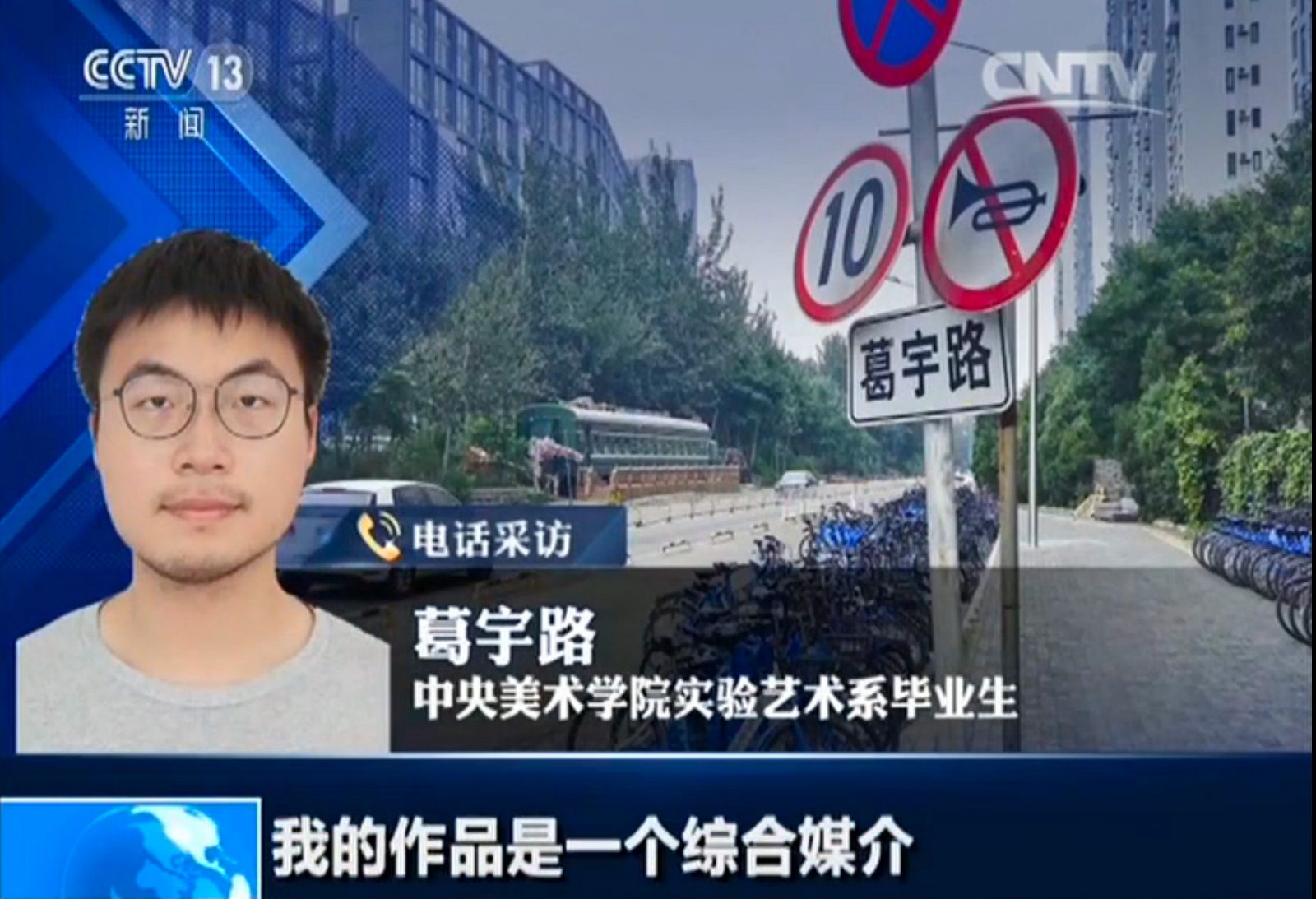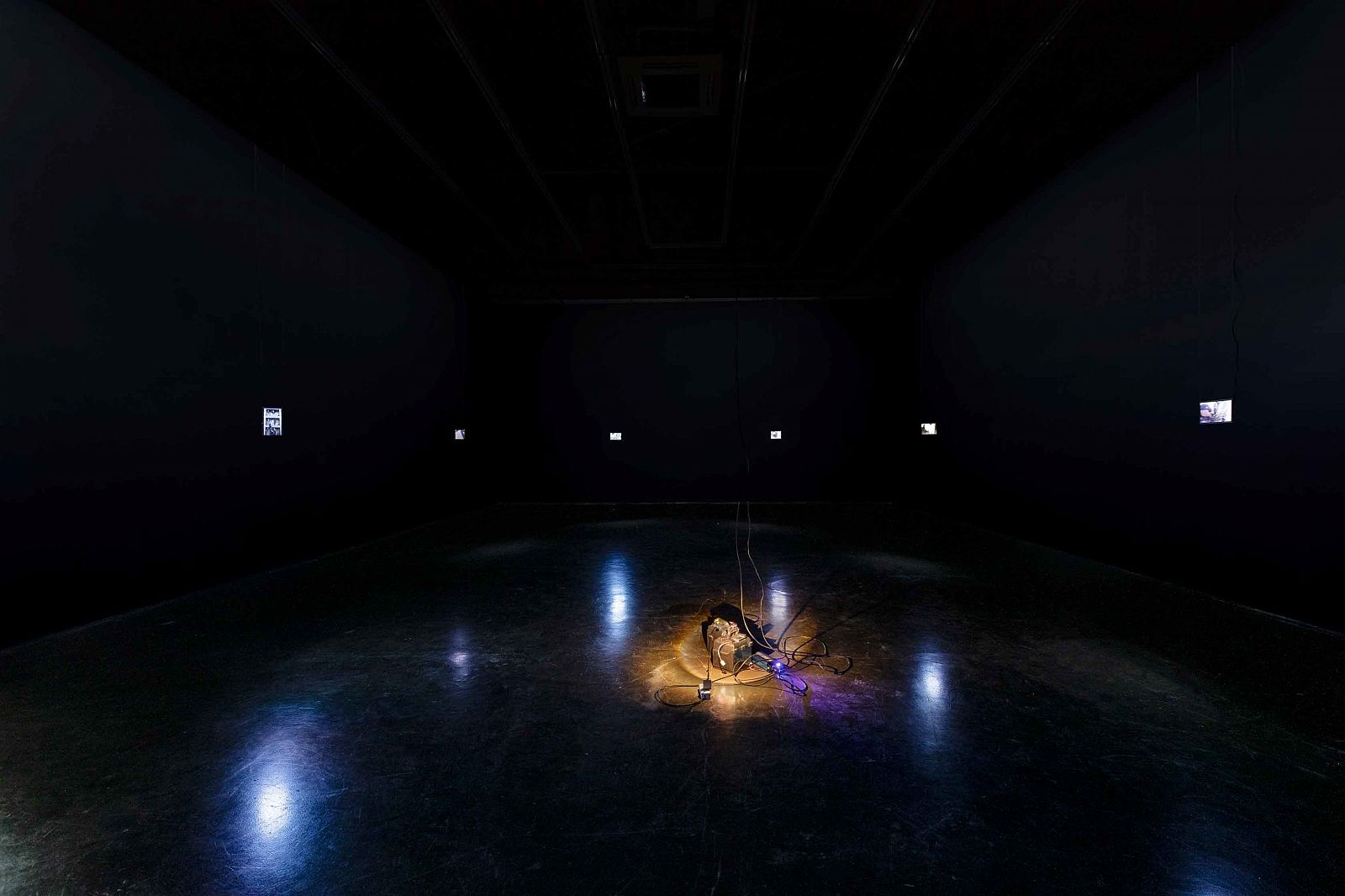During his livestream, Ge Yulu — who hails from Hebei Province — rode an electricity-generating bicycle he’d modified himself, trekking dozens of kilometers to Beijing Commune, inside 798 Art District. Throughout the trip, the artist’s kinetic energy was transformed into the electric energy stored within a battery strapped to the bicycle, thus becoming the sole power source for the eight monitors inside the exhibition space. Each displayed one of Ge’s past performances. Perhaps in the interests of saving power, the artist aggressively trimmed down the lengths of these films, such that they seem short and scattered, abruptly ending once you go in for a closer look.
Or perhaps, when you’re about to turn from one to another, the entire exhibition space will go black — power’s out.
Each day for which the exhibition is open, Ge will repeat his labor, generating electricity with his bicycle; he is sometimes forced to ride furiously in the storehouse of the gallery. Yet this Sisyphusian task can provide, at the most, an hour’s worth of electricity. In the only artwork of solo exhibition Ge Yulu, Emergency Power System (2020), the limits of the artist’s physical endurance determine the duration for which the exhibition can function normally. Outside of the exhibition space, Ge Yulu frequently interacts with audiences on Weibo. Thus, the Schrodinger-esque conditions of the gallery can be somehow predicted ahead of time: either you get lucky, and see the show when it is running, risking power outage; or you rush to the gallery space, only to be told that the generator battery has run out of power. Audiences take different sorts of perceptions to the exhibition space; whichever state of the exhibition they find themselves in, they immediately curious to experience its alternative. The indeterminate nature of the exhibition’s equipment and facilities are transformed into the audience’s anxieties, the imagined stable provision of electricity slowly becomes the very thing the exhibition is about. Once viewers realize this, their anxiety changes into a skeptical reconsideration of such “common sense.” Those solid truths we took for granted, it turns out, were fantasies all along.
In Ge Yulu, the artist uses simple electric generating equipment to simulate a sudden, large-scale societal collapse; this scene, charged with a sense of déjà vu, seems an obvious allegory, one that everyone understands, but no one wants to take seriously — much like the start of 2020. Yet when viewers walk inside the gallery, the face masks, infrared thermometers, and entry permits forcibly remind them of the ineradicable, collective fear at the beginning of the year. In this way, a kind of emotional loop is produced.
Today, these emotions spread — as astoundingly quick as the pandemic itself — throughout the entire globe, such that social safety nets and loss of government confidence has become, for once, a text and context understood on a planetary scale. On the other hand, since the outbreak of Covid-19, art institutions have exhausted themselves creating online exhibitions, attempting to move a physical place for viewing art onto online spaces. As everyone thinks up ways to improve online viewing, Emergency Power System, a tangible work of art, shown in a brick-and-mortar space, has certainly performed well in key metrics for gallery viewership — making the prospect of online exhibitions pale in comparison.
To save power, every part of the exhibition space has been designed to with an eye to economy. However, another part of the show — the livestream that captured so many viewers — is broadcast independently of the things powered by the battery. The artist livestreams his bike ride outside of the gallery space, leaving the glaring monitors like apparitions hovering in the air of the gloomy exhibition space, becoming the least important part of the show. They seem, rather, like battery indicators, sending out a slightly stronger signal in the instant when power runs out. In the pitch-black gallery, visuality and aesthetic sense no longer work in tandem, and instead devolve into simple sensory systems, instruments for Ge Yulu to induce audience anxiety. The exhibition space’s variable light conditions do not allow it to transform from a white box or black box into a new model of visual presentation; it sheds its last bit of piteous aura, and transforms into an expendable place, given to viewers only to prove that wide-travelling concept — to power a gallery space by riding a bicycle. The actual site of the exhibition no longer matters, not because its own functionality has been stripped away, but because it lacks the power to attract more attention.
Now it seems that the efforts to reproduce physical exhibitions online through technological means, and attempts to give audiences’ mechanical eyes, to turn exhibitions into take-out affairs, all miss the forest for the trees. Because of the union of art exhibitions and the internet, the important thing has stopped being how to improve the experience of gazing at a monitor — it has become how to realize (new) interactive modalities with viewers. The intention of Ge Yulu’s solo exhibition was not to present itself “online,” but in reality, it was a broadcast success, of the kind that most online exhibitions these days can only dream of. The transition online of art shows is not merely a stopgap measure to deal with the Covid-19 outbreak; it ushers in the end of the era of exhibitions as we know them.
This destiny has begun to manifest itself, already, in Ge Yulu’s exhibition. To Ge, the physical show is not an essential organ — it is, instead, a kind of appendix. In the exhibition space, each viewer’s gaze is interrupted by these scattered films and abrupt power outages — each is at a loss for what to do. Together, the exhibition and the livestream event expose the technological framework of the show; but the artworks — actual substances — have dissolved from this space. The ways of seeing that permeate our new normal have obviated the need for viewers to personally visit the gallery space in order to experience the indeterminate nature of these artworks. Even without this physical site for viewing art, however, viewers can consult the current, social context as they participate in constructing the show’s meaning; they can make waves in the comments section of various social media platforms. In reviews of the exhibition, the pictures used to analyze the works are no longer painstakingly composed; on the contrary, it is screenshots of Weibo comments, or even of CCTV video feeds, that back up the text. When we search through Ge Yulu’s past practice, we discover that his performances were often first “discovered” in the general news, not in art publications. Their earliest viewers were seldom well-prepared exhibition goers, but netizens who’d stumbled on them. The space of viewing art thus goes from the gallery to web, where livestreams, bullet screens, comments, responses, forwards, and likes all happen in real time. Viewing, broadcasting, and commenting on a work of art happens in tandem. When we interact with the artist on Weibo, do we realize that this is the historical end to traditional exhibitions, the annunciation of a new art world?
The pig’s coming out of the sty has allowed Ge Yulu to achieve widespread social recognition. Though online traffic is hardly the measure of an exhibition’s success, it is the capital which allows the artist to continue working. Ge has always been using his privilege as an artist to stimulate societal discussion: using his authority to demand answers from authority, seeping through the present order to question this order, he attempts to make the elephant in the room cry out. In his work Cost Performance (2019), he uses his identity as participating artist to audit and then display an art institution’s financial situation and its expenditures. Much like our own ignorance of the enormous electric infrastructure that undergirds our everyday lives, an art institution’s account books are seemingly never part of a normal viewer’s purview. However, it these overlooked infrastructures that sustain numerous parts of society. Through active, embodied dialogue with these institutions, Ge Yulu turns performances into social events, allowing the act of performance to break free of the strictures of visual presentation and become art itself. Before Christo and Jeanne-Claude realized their Wrapped Reichstag (1971–1995), they had to undertake a 20-year lobbying campaign. This slow process of negotiations was itself a kind of democratic practice, done in the name of art. However, unlike the majestic human-made sights that these two artists eventually presented, Ge Yulu’s artwork probes social systems from a more romantic, private vantage point. Ever since he named a street after himself in Ge Yulu (2014–2020), or his hours-long visual exchange with a security camera in Gazing Back (2016), he has found a feather to both make society laugh and cry. Unlike in previous artworks, where he singlehandedly cried into the abyss, in Emergency Power System, Ge has now sent out invitations to his viewers to watch him together.
Perhaps, amassed before all the security cameras in different streets and alleys, more people will now lift their heads and gaze back, thoughtfully.
Translated from the Chinese by Henry Zhang.
Chen Yujian is the editorial assistant of Heichi Magazine.
Henry Zhang is a translator who lives and works in Beijing, China.



